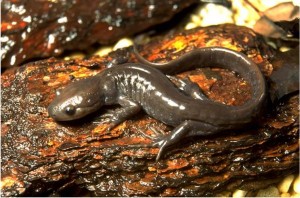Species gain new ground under Endangered Species Act
 TORONTO – The Save Ontario Species coalition (S.O.S.) is happy for the Jefferson salamander and the wood turtle, not so much for the American badger. The three are among nine endangered species that have just received habitat protection under the Ontario government’s Endangered Species Act (ESA).
TORONTO – The Save Ontario Species coalition (S.O.S.) is happy for the Jefferson salamander and the wood turtle, not so much for the American badger. The three are among nine endangered species that have just received habitat protection under the Ontario government’s Endangered Species Act (ESA).
Ten habitat regulations were scheduled to be in place by June 2009. Nine have been completed for the following species: American badger, barn owl, eastern prairie fringed-orchid, Engelmann’s quillwort, few-flowered club-rush, Jefferson salamander, peregrine falcon, western silvery aster and wood turtle. The woodland caribou regulation has yet to be released.
S.O.S. is pleased with several of the habitat regulations, noting that those for the Jefferson salamander and the wood turtle set a particularly strong precedent by closely following the science-based recommendations of the recovery teams.
“We’re happy to see that the habitat regulation for the Jefferson salamander takes an ecological approach and protects breeding, overwintering and migratory grounds,” says Amber Cowie, greenway conservation coordinator for Ontario Nature. “We hope that this regulation gives the salamander a toe up in its fight to survive amid the development pressures that continually threaten its home.”
The Jefferson salamander is a tiny amphibian with four front toes and five rear toes that lives under logs, in loose soil or in leaf litter. It is threatened with extinction in Ontario mainly because of habitat loss and degradation.
The wood turtle will also receive greater protection against habitat loss as well as poachers in the pet trade.
“This is a species that is declining across much of its range,” says Dr. Anne Bell, Ontario Nature’s senior director of conservation and education. “Given the impact of habitat loss and degradation on these turtles, it was critical to make sure that the habitat needed for nesting, feeding and hibernating was covered. The government has delivered a strong, science-based regulation for the wood turtle.”
Under Ontario’s Endangered Species Act, a habitat regulation does not restrict all land uses, but rather defines the area where the Ministry of Natural Resources (MNR) will regulate harmful activities. Activities that do not harm habitat can occur without change. Activities that harm the habitat can only proceed if the MNR issues a permit.
Many southern species such as the barn owl and badger have learned to eke out an existence in an already altered rural landscape. In many cases, habitat protection for these species means maintaining current land uses; for example, keeping working farms working and protecting against development.
The badger habitat regulation was an opportunity to break new ground in how habitat in working landscapes could be defined. Instead, the regulation sets a poor precedent by reducing habitat to actual badger residences, few of which are known.
“We recognize that habitat identification for the badger is not easy, but a more precautionary approach should have been applied here,” says Rachel Plotkin, biodiversity policy analyst at the David Suzuki Foundation. “A five-metre buffer around known dens does little to protect this highly secretive and imperilled creature.”
Estimates suggest that fewer than 200 badgers remain in southern Ontario.
-30-
For more information contact:
Anne Bell, Ontario Nature – (416) 444-8419 ext. 239
Amber Cowie, Ontario Nature — (416) 444-8419 ext. 273; 647-330-3576 (cell)
Rachel Plotkin, David Suzuki Foundation – (613) 594-9026; (613) 796-7999 (cell)
About Save Ontario’s Species: S.O.S. is a collaboration among CPAWS Wildlands League, the David Suzuki Foundation, Ecojustice, Environmental Defence, ForestEthics, and Ontario Nature. For more information, visit www.saveontariospecies.ca .